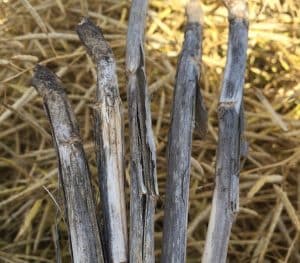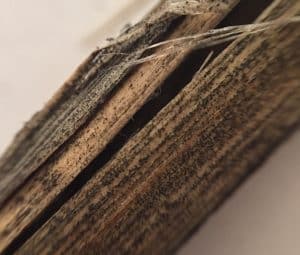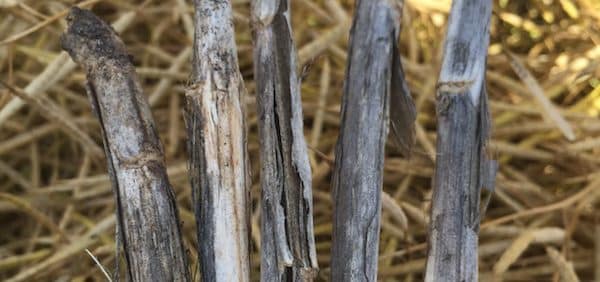Disease scouting long after swathing is not usually the most accurate, as saprophytic organisms — those that feed on and break down dead material — move in fast and cloud the identification process.
Verticillium is one disease that can be more obvious and easier to identify after cutting a canola crop. As the plant dies, verticillium microsclerotia — if present — will start to grow under the stem’s skin.
Specks of black underneath the outer layer are likely verticillium. Specks of black on the outside are likely blackleg. As cut stems start to dry, vertilicillium microsclerotia will be widespread on infected plants. Some peeling of the outer skin may have started. Use a hand lens to look for the specks. Read more: www.canolacouncil.org/canola-encyclopedia/diseases/verticillium/
If you find verticillium: The disease has fairly low incidence and low severity on the Prairies. While finding the disease is worth noting, so far the disease is not really influencing yield as it comes in so late in the season.


Here are some tips to identify other diseases based on stem analysis at this stage of the season:
—Soft rot is likely sclerotinia. If you squeeze damaged stems and under moist condition they’re mushy, sclerotinia stem rot is present. Dry stems that shred apart easily leaving mostly strands of fibres in the stem are clear indication of sclerotinia infection – even if you don’t find the tell-tale black sclerotia in the stem.
—If the squeezed stem is hard, cankers are present and clipping show blackening inside the stem, blackleg is likely present. At this stage, you can’t accurately quantify how bad the disease was in the plant at the time of cutting, but this can be useful to identify presence of disease in the field.
—Grey stem symptoms — look for a grey stem — can be common in a wet harvest. Clip the step to distinguish it from blackleg. Grey stem will not have blackening inside the stem.
—Alternaria is often all over cut canola plants and stems: This fungus infects living plant but is also an active saprophyte. Alternaria is a common cause of blackening pods, branches and stems as the windrow cures or standing plants die off.
Some diagnostic labs on this list can test canola pieces for the presence of major diseases as well as verticillium.
Links and further reading:
Blackleg scouting more difficult as time passes
Canola Encyclopedia section on diseases
VIDEO: Post-swathing disease scouting

